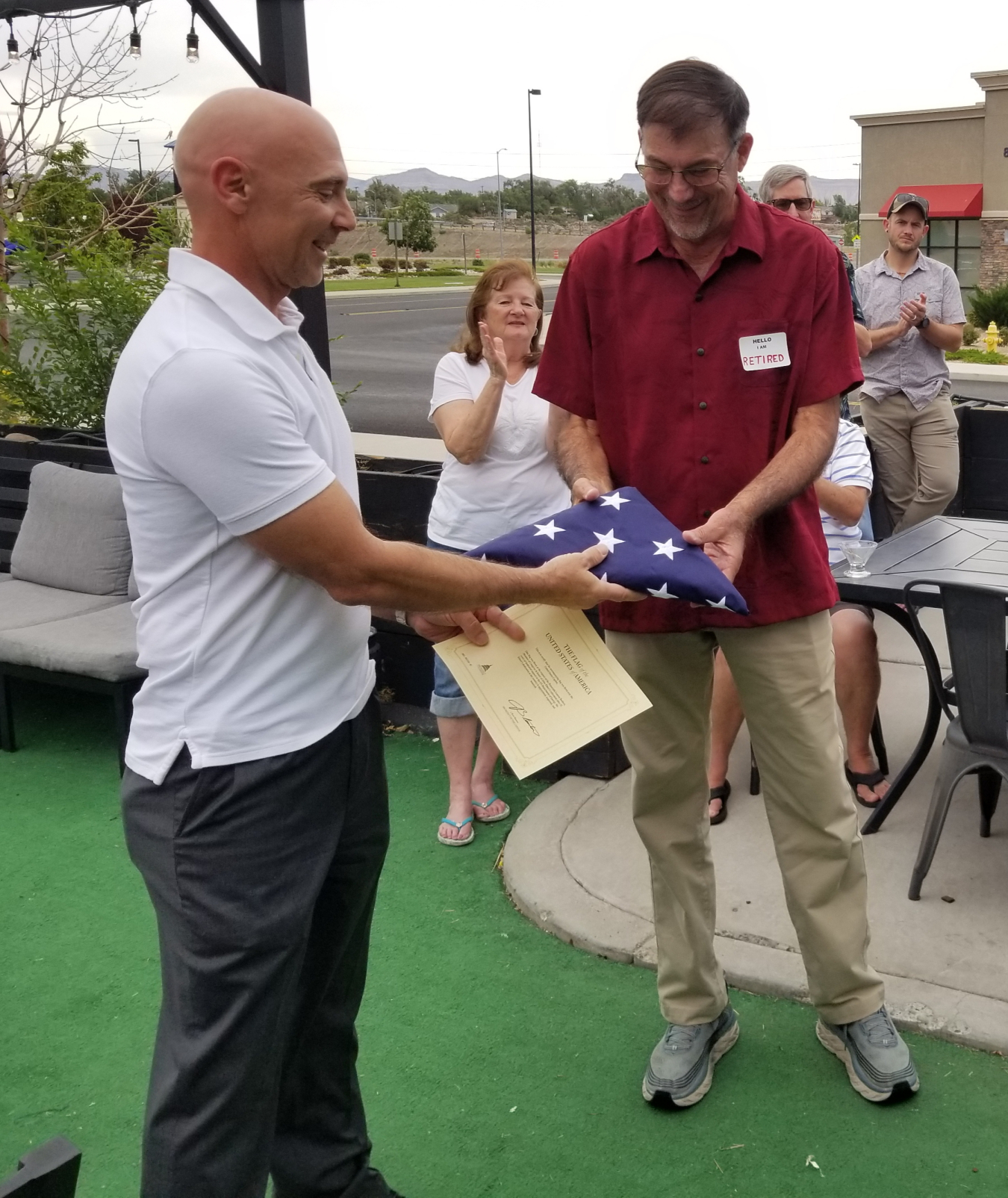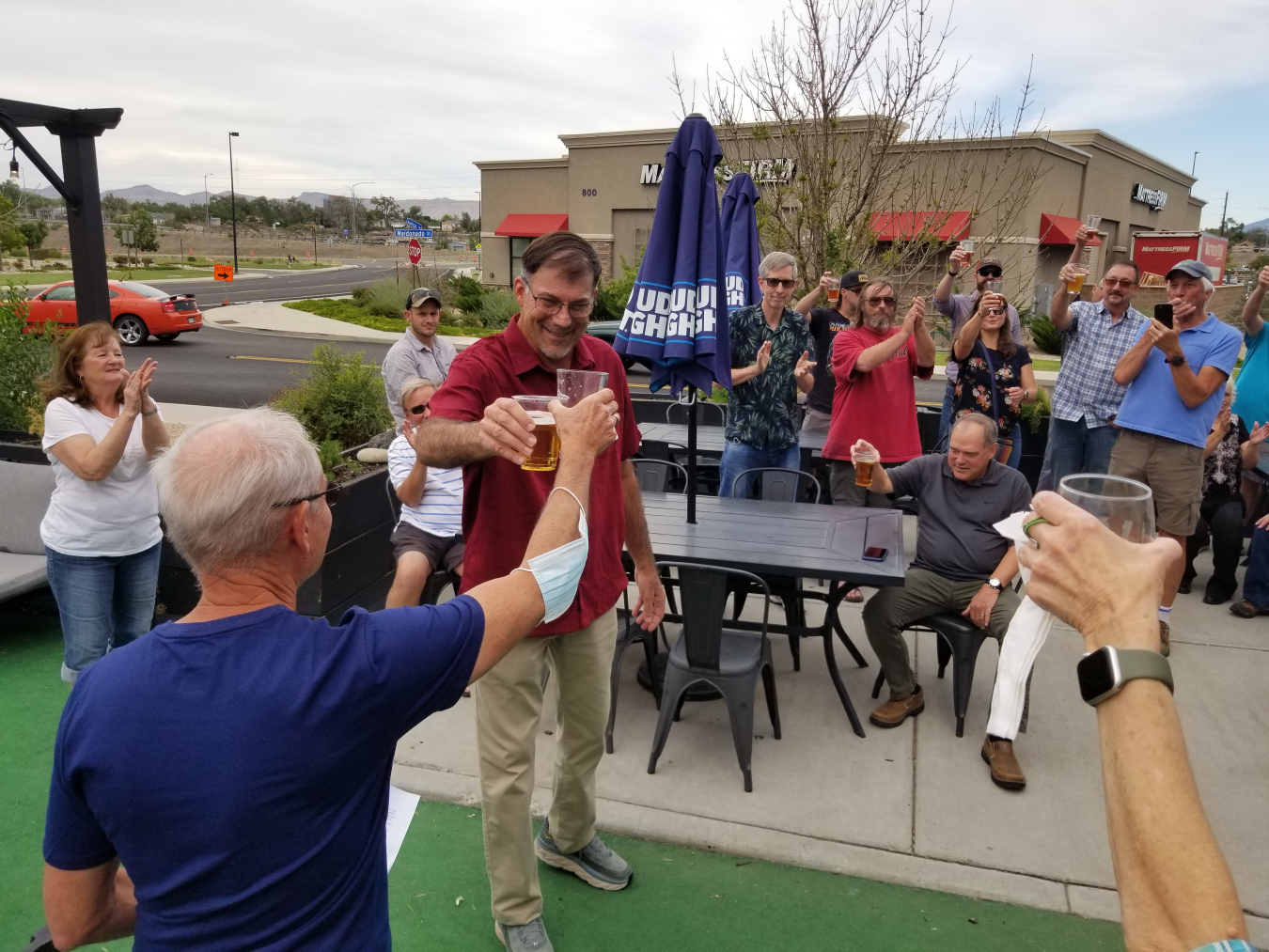As John Elmer wraps up more than three decades of work with the U.S. Department of Energy (DOE), he’ll look back on his many accomplishments with an immense sense of pride.
September 2, 2021As John Elmer wraps up more than three decades of work with the U.S. Department of Energy (DOE), he’ll look back on his many accomplishments with an immense sense of pride.
Those who have worked with him will always be grateful for his expertise and helpful attitude.
“John has a calming effect on me,” said longtime colleague Mike Butherus, who worked with Elmer through the challenges of the program to remove uranium mill tailings from thousands of sites in Grand Junction, Colorado.
LM-21 Supervisor and Field Manager Paul Kerl appreciates Elmer’s steady demeanor and depth of knowledge.
“I’m grateful for the opportunity to have worked with John over the last two years. He’s the epitome of a professional; always kind, helpful, and supportive,” Kerl said. “He’s a wealth of information, history, and stories associated with our programs. I greatly appreciate everything he’s done for the Department of Energy and our Office since its inception.”

LM-21 Supervisor and Field Manager Paul Kerl hands John Elmer a flag that flew over the U.S. Capitol in honor of Elmer’s many years of service with the U.S. Department of Energy.
Elmer said because of his upbringing, a career in civil engineering seemed like a natural fit.
His dad was a research chemist who envisioned a career in medicine for his son. His mother was a math and science teacher, “so I grew up in a household of science and math,” he said.
“My high school counselor saw those strengths and steered me toward engineering,” he said. “I remember looking at the brochure for [Colorado State University] and decided civil engineering would be the best discipline because you got outside more.”
Early in his career, he was a design engineer/project engineer working on infrastructure projects, mostly designing water and wastewater treatment plants. He said his favorite projects were in the Colorado ski towns of Crested Butte and Telluride, and in Jackson, Wyoming.
That path eventually led him to long years of service with the DOE. He began work on the contract in 1989 and took the role of manager of engineering for Monticello Remedial Action Project, Monticello Vicinity Properties, and Grand Junction Project Office Remedial Action Project designs.
Elmer said the project he found most satisfying was the Uranium Mill Tailings Remedial Action (UMTRA) vicinity property cleanup of more than 4,000 properties in Grand Junction.
“In 1989 when I joined the team, it was still ramping up toward a very difficult challenge,” he said. “When I took over as program manager in 1993, we were spending $35 million on the cleanup of 500 properties a year, which today would be almost impossible to accomplish.”
“It was a very successful project and a great team to work on; it created a lot of good jobs and cleaned up areas that led to great public amenities, such as the [Colorado] Riverfront,” he said. Once the project was complete, “the city held a street party for us,” he said.
The mission to remove hazardous materials from Grand Valley properties brought with it enormous challenges, Elmer said.
“In the UMTRA vicinity property program we were faced with some very difficult remediations, primarily ones involving hazardous waste mixed with mill tailings,” Elmer said. “It took us years to negotiate an approach to minimize DOE’s liability. Probably the most challenging was the Hanson Container (formerly Layton Brothers) drum-recycling facility, where there were tailings, yellowcake, numerous contaminants, and lead in the soil.
“Working with [the U.S. Environmental Protection Agency], Colorado Department of Public Health and Environment, DOE (both HQ and Albuquerque offices), attorneys from all three organizations, we were able to work out agreements, roles, and cleaned up the property. The cleaned-up property is now part of the Riverfront,” Elmer said.
Kerl said Elmer was also instrumental in the kickoff of a major mill-tailings project in Moab, Utah, was a key contributor to the origins of the Long-Term Surveillance and Maintenance program, and played a major role in starting the Defense-Related Uranium Mines program.
Sam Marutzky, foreground, toasts John Elmer at Elmer’s retirement party in Grand Junction on Aug. 26.

Sam Marutzky, foreground, toasts John Elmer at Elmer’s retirement party in Grand Junction on Aug. 26.
Elmer said that at that time, he had been working with David Shafer and Dave Geiser, then director of the DOE Office of Legacy Management, on uranium contamination issues and potential litigation issues with the Navajo Nation.
“Dave Geiser saw the need and started working with congressional subcommittees to gain support for a DRUM-like program,” Elmer said. “So, when Congress assigned DOE to write the Report to Congress on Defense-Related Uranium Mines, I took the lead. We had a year and a half to collect the data, identify the data needs, write four supporting papers, and then eventually write and create [the report].”
Elmer’s career took him to many far-flung sites, but he says he’ll never forget his trips to the former Soviet republics of Kyrgyzstan and Tajikistan in central Asia.
After touring the whole country, Elmer said Kyrgyzstan in particular, reminded him of the drive from Ouray to Durango, “but looking at 20,000-foot peaks,” he said.
“Although the cities are modern, rural areas look like they are a throwback to the 1950s. I won’t miss the lack of plumbing and what was mostly outhouses with just a hole in the ground (that’s a different story). One thing that sticks out is when we went to order in a restaurant, the menu was limited to mutton, goat, and some mystery meats, and typically it was served with only onions and maybe a few potatoes. Meat was generally high in fat and gristle. I nibbled at the meat part, like a spoiled Westerner. The Kyrgys ate it all.”
He's encountered some strange situations in his long career with the DOE, but one experience during an inclusion survey stands out in his mind.
“A survey team came across a house with a very high and unusual gamma field that they couldn’t initially discern where the source of radioactivity came from,” he said. “After pulling items out of the house they found a vial of radium salts in a trunk; the vial was a gift from Madame (Marie) Curie to the owner’s father.
“Because of the high gamma field, the vial obviously presented a health risk to the inhabitants of the house, so they were encouraged to hand it over for proper management. The owner agreed that DOE could take possession as long as it wasn’t destroyed. The vial was eventually transferred to Texas A&M University so it could be part of a Madame Curie exhibit they put together.”
At Elmer’s retirement party in Grand Junction on Aug. 26, Kerl presented Elmer with a flag that had flown over the U.S. Capitol in honor of Elmer’s service with the DOE.
“We owe you a debt of gratitude,” Kerl told Elmer. “You can retire knowing that you’ve made a difference for the community and the nation.”

